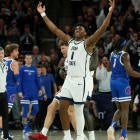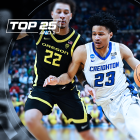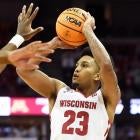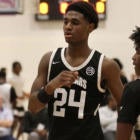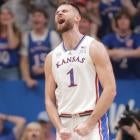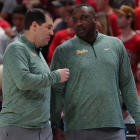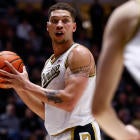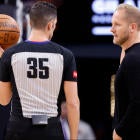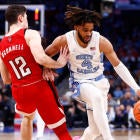
Twenty-five years ago, the Mountain West was born out of the rib of another entity, the Western Athletic Conference, and from that genesis came a union of eight schools. These institutions boldly broke free on the brink of a new millennium. Their newfound ties spanned two time zones (how quaint) and spread from the Rockies to the Pacific Ocean to the elevated deserts of New Mexico and up into the high plains of Wyoming. The league's outposts were a comical culture clash: SoCal chill; Colorado crunchiness; the United States Military Industrial Complex; Mormonism; and, naturally, the Las Vegas Strip.
The power, persuasion and promise of college sports glory, as we've seen through repeated fractured stages of realignment, can bring pretty much almost anyone together. And so it did then, in 1999, with Air Force, BYU, Colorado State, New Mexico, San Diego State, UNLV, Utah and Wyoming.
Today, six of those original eight remain; BYU eventually bolted for the WCC and is now in the Big 12, while Utah will join its Holy War brethren later this year after abandoning the Pac-12. Over the years, the Mountain West bolstered by bringing aboard Boise State, Fresno State, Nevada, San Jose State and Utah State to get membership (for now) to 11 schools. So many of these decisions are made for football, but it's March, and we're here to talk about hoops. Over the past two and a half decades, the Mountain West's held a sturdy-yet-fluctuating place in college basketball, ranking top-10 at KenPom.com in all years except one (2020-21; it was No. 11).
In this silver jubilee season, the Mountain West has morphed into the most reliably entertaining conference in the sport. It's a riot. Every week. Twenty-eight MW games were decided by five points or fewer. A few more forthcoming are all but guaranteed to push that number beyond 30 by the end of the Mountain West Tournament this week in Las Vegas.
𝘽𝙧𝙞𝙣𝙜 𝙤𝙣 𝙩𝙝𝙚 #𝙈𝙒𝙈𝙖𝙙𝙣𝙚𝙨𝙨
— Mountain West (@MountainWest) March 10, 2024
Here's your first look at the men's championship bracket 🏀 pic.twitter.com/3N9cbvyoZn
"It's such great basketball, you never know what's going to happen," commissioner Gloria Nevarez said. "Last-second shots, overtimes, it's really been amazing. When we think about what's happening in college athletics, where we are in the environment, we are definitely competitive."
This is no Cinderella story, but it is an inspiring conference uprising from which a lot of leagues can learn. The MW's record for NCAA Tournament bids is five; it could break that mark on Sunday. Utah State, San Diego State, Nevada, Boise State and Colorado State are all locks. New Mexico is dancing on the cut line to be team No. 6, while UNLV is a No. 4 seed in the tourney bracket and the most obvious dark horse of them all to rip the auto bid.
They play this tournament on the Runnin' Rebels' home court, after all.
"I really appreciate the folks that watch basketball, our committee reps, understand the strength of play," Nevarez said. "It's good problems to have when you're as deep as we are and you beat up on each other."
If the Mountain West's postseason matches the paroxysms of its regular season, this will be the best bracket before the Big Bracket. Guaranteed. To wit: The top seven teams' chances of winning the conference's auto bid are separated by a grand total of 4.8 percentage points. Utah State's the highest (14.6%), Colorado State's the lowest (9.8) among the top seven teams. That is perhaps unprecedented and speaks to the fortifying balance in the conference.
We've seen last-second heroics for 10 weeks with this group — none more outlandish than this heave by Nevada's Jarod Lucas at Colorado State on Feb. 27.
JAROD LUCAS HITS A HALF COURT SHOT FOR THE WIN 🤯
— Yahoo Sports (@YahooSports) February 28, 2024
(via @CBBonFOX)
pic.twitter.com/xSDy6oRZFk
Does the league dare try to top itself In Vegas?
If you've been watching all season, you've been tossed into a chaos blender in witnessing these Rams and Aztecs and Wolf Pack and Lobos and Aggies and Runnin' Rebels and Broncos bust up on each other and lift the Mountain West to sustained relevancy in the process.
"It's so different when it's a conference game. The electricity and the energy," Utah State coach Danny Sprinkle, in his first season in the conference, said. "When you go into The Pit in a conference game, and Viejas (Arena), it's totally different than when I'm going with Cal State Fullerton or Montana State. That's what makes the Mountain West special, is the venues. It's the best on the West Coast, when you take, overall, the league's venues. When you're playing every game in the Spectrum, there can't be five better arenas in the country."
Sprinkle is fresh off winning a standalone Mountain West title — Utah State's first in its history — and did so without returning a player who scored a point for the program last season.
"For this team to have a chance to win, we had to we had to do the little stuff," Sprinkle said. "And and a lot of our guys hadn't come from winning programs. They didn't know a lot of this stuff and it was a fight. It was a fight every day from all summer, all fall. And I mean, even throughout the season up until Christmastime, when the guys really started to believe it."
The league has been thriving amid a transition that many in college athletics were eying: Nevarez took over as commissioner in January of 2023, replacing Craig Thompson, who served for 24 years and was the only commissioner the Mountain West ever knew. Beyond that, the transfer portal now looms as a potential threat to dilute a league's depth and familiarity. That didn't happen here. The Mountain West lost 43 scholarship transfers across 11 teams (four transfers per school on average) last season but retained key stars such as Isaiah Stevens (Colorado State), Jaedon LeDee and Lamont Butler (San Diego State), Jaelen House and Jamal Mashburn Jr. (New Mexico), Kenan Blackshear (Nevada) and Tyson Degenhart (Boise State).
"The main thing you have to do is you have to get really good players," Sprinkle said. "They make coaches look good."
At Utah State, Great Osobor and Darius Brown came with Sprinkle from Montana State and were some of the most impactful transfers in the country.

There was also intention amongst the coaches in recent years to refocus scheduling efforts. San Diego State made the national championship game in 2023, marking the only time the Mountain West had a team make the Final Four. It finally brought a dash of validation to a conference that was a mess in March years prior. This season, the conference claims 35 Quad 1 wins. Five schools rank in the top 40 at KenPom and seven are in the top 75 for the first time in league history.
"What I respect and appreciate the most is we talk about scheduling all the time, and what our coaches are doing in nonconference, without any mandates or guidelines, is beautiful," Nevarez said. "All of our head coaches, regardless of where they were with rebuilding or angling for seeding, did that really effectively."
The Mountain West posted a .730 nonconference win percentage, the league's best showing since its banner 2012-13 season that saw five of its then-nine schools make the Big Dance. Nevarez referred to the "three levers" that guide the league to maximizing its chances for the most bids: reasonable-but-ambitious nonconference design, format for regular-season play and format for the league tournament bracket. The league was sure to balance its 18-game conference slate by having every projected top-six team play other top-half teams twice. That model (utilized by many leagues) ensured that MW teams were helping each other's rankings once they got into league play, provided they didn't betray their performances from the first eight weeks of the season — which they did not, by and large.
"What I appreciate about our coaches room is they're all growing in the same direction," Nevarez said. "They all want to elevate, they all want to win, there is zero complacency. ... Our coaches are educated, they understand how the NET works and they're doing it. ... We've always been able to refresh, rebuild and stay competitive."
Moving into next season, the Mountain West will go from 18 to 20 conference games and institute a double round robin, just as the Big East does. It's the most equitable way to crown a champion and eliminate imbalance issues that can unexpectedly pop up as the season goes along.
Before we get to that, the next few weeks loom large. The Mountain West gets its next big moment this weekend when the semifinals air on CBS Sports Network Friday night and the championship airs on CBS Saturday (6 p.m ET). Expect bedlam. From there, expectations jump. That 2012-13 year I referenced? Do you remember much about it? Likely not. That's because the league sent five teams dancing and went 2-5 with zero Sweet 16 teams.
There can't be one team showing up and everyone else being a one-and-done. To change its reputation, the Mountain West has to get multiple teams into the second weekend. It's unlikely any school will be seeded as well as No. 3 — San Diego State, Utah State, Nevada and Boise State could all wind up somewhere in the 4-7 range. But the conference is poised to have more schools wearing home whites for the first round of the NCAAs than ever before. This is its best window to out-perform multiple high-major conferences.
The most entertaining league in the country awaits an opportunity that's been building since San Diego State made it to the national championship game on a buzzer-beating shot last April. A Final Four run isn't required, but getting two or three teams into the second weekend would go a long way to supporting the season-long thesis it's provided, in extravagant fashion, for the past few months.
The Mountain West is legit.
Richmond rebounds a year after Chris Mooney's heart scare
A year ago this month, Chris Mooney was supine on the couch in his living room, recovering from heart surgery.
Today, he's thriving on the heels of coaching Richmond to its first regular season Atlantic 10 championship in school history.
But let's go back a year. In mid-February 2023, Richmond announced Mooney had to step away because of an "aneurysm in his ascending aorta" that required immediate attention. It started with an annual physical, which included a calcium test to check on Mooney's heart. Imaging showed a blockage. Mooney's doctor called and asked what time he'd be home to talk. Mooney told him, and then the doc asked if he could meet him there.
"So, you know, I knew it was obviously something pretty big," Mooney said.
An aneurysm is defined by the Mayo Clinic as "an abnormal bulge or ballooning in the wall of a blood vessel. An aneurysm can burst. This is called a rupture. A ruptured aneurysm causes bleeding inside the body and often leads to death." Surgery is considered at 50 millimeters. Mooney's was ultimately measured at 57, meaning the matter went from heart surgery in the near future to heart surgery in the immediate future.
"Shocking," Mooney said of the diagnosis because he had no family members with a history of heart issues. "The two biggest indicators or predictors would be family history or smoking, which neither applied. The doctor just said it's bad luck and they don't know if it was 57 millimeters since I was 20."
Mooney's best friend happens to be a heart surgeon and recommended one of the best in Virginia, which eased his nerves.
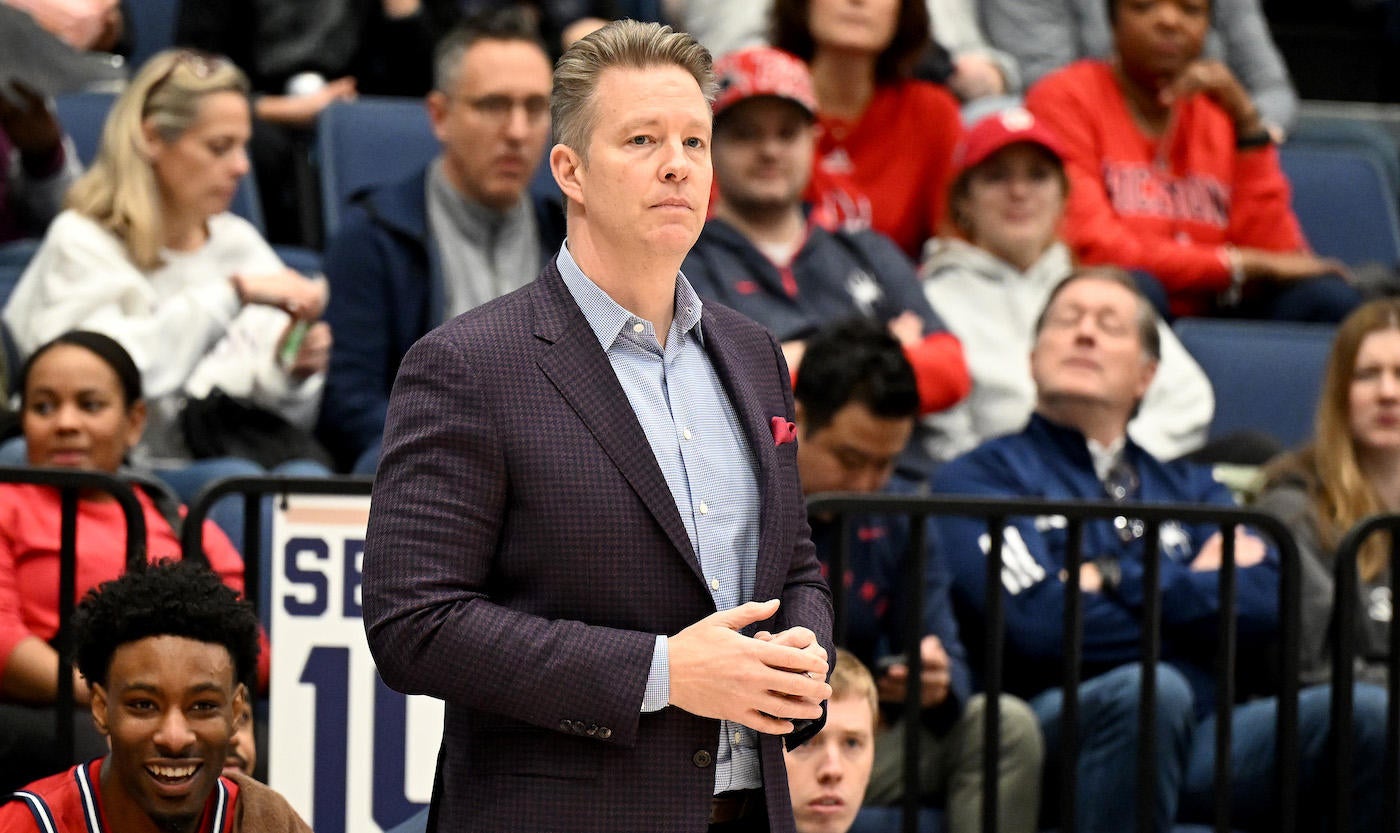
He was also cooled by the fact that his condition, while not desired, was more common than people realize. They cracked Mooney's sternum, tended to the aneurysm and kept him in the hospital for four days. Then, a month at home to recover.
"Had it been the same job 10 years ago with no portal, I probably would have been able to ease into it to a certain extent, but this was extremely busy time," he said. "And so we were right back out."
Not a great commentary on the the sport that a coach undergoing heart surgery feels compelled to quickly return to work within a month of being cut open, but return to work Mooney did. The portal was packed. Richmond lost four players, including Tyler Burton to Villanova, and eventually signed three transfers. One of them was Jordan King, via ETSU, who has been a stud this season: 18.5 points per game and a 42.6% from 3. Richmond is 23-8 and co-champs of the Atlantic 10. It's been a major shift from a year ago when UR finished 15-18 and had heavy questions looming over the future of the program.
What makes Richmond's rise surprising is how Mooney and his staff have been able to navigate the portal and NIL at a place that was lean on transfers in the past. Richmond is not an easy school for many players to clear academically, so its pool of options is smaller than most others. It would've come as no surprise if this team wound up finishing, say, seventh in the A-10 instead of first.
"This has been fairly new to us," Mooney said. "If you feel like your talent needs to improve, you might be willing to compromise. And understandably. But I think that we got very lucky with these last two groups of transfers."
They'll play at Barclays Center this week as the top seed. (The semifinals will air on CBS Sports Network on Saturday, then the title game on Sunday on CBS.) The Spiders have a shot to make their second NCAA Tournament in three years because of guys like Dji Bailey, a senior who didn't seek a transfer, and DeLonnie Hunt, a "one of one" leader.
"Willing to be loud, willing to be vocal, willing to do all the hard stuff willing to put himself out there," Mooney said of Hunt, a transfer from Wagner. "Somebody I've never seen."
Mooney is one of the longest-tenured coaches in college basketball, something he doesn't take for granted and certainly didn't after undergoing heart surgery. He's coached Richmond since 2005 and won close to 400 games. The Spiders have six top-four Atlantic 10 finishes on his watch, but it took until 2024 to finish atop the league ledger. If Richmond cracks into this year's NCAA Tournament, it will be its fourth Dance under Mooney in 19 years. The only coaches with longer runs in A-10 history are John Chaney and Phil Martelli's 24 seasons apiece at Temple and Saint Joe's, respectively.
Less than a decade ago, aggravated fans put up billboards in Richmond that advocated for Mooney's firing. Ask most around the sport and they'll tell you the truth: Richmond's lucky to have a guy like Mooney running that program for two decades.
@ me
The final mailbag of the season!
Genuine question, Why is UNC the 2 seed in the east in every 2 seed scenario?
— Sam Rardin (@Sam_Rardin) March 11, 2024
Because UConn is the No. 1 no matter what in the East and has basically had that spot on lock for two-plus weeks at this point. The committee tries to provide geographic favorability to the top four seeds in each region (if achievable) while also providing competitive balance. If North Carolina winds up as the highest-ranked 2-seed, it may well get shipped out West with the lowest No. 1 (likely Tennessee). But it's possible UNC is also in the East with UConn. Either way, the Heels will start tournament play the first weekend in the Charlotte pod.
Is that a seed line loss? @MattNorlander @ArizonaMBB
— Tony Roe (@tonysroe) March 10, 2024
Yes. I believe Arizona's loss at USC on Saturday disqualifies the Wildcats from contention for the final No. 1 seed. Whether that matters remains to be seen, because 'Zona is almost certainly going to be the No. 2 in the West. That said, Tommy Lloyd's team was a 2-seed last year, and well, we remember how that ended.
📬 Dude Diligence via Bluesky: Does Jake Diebler have a realistic shot at keeping the Ohio State job?
I don't think so. Last year, Rodney Terry had basically two more months to prove himself at a similar-level job and barely got the Texas gig, needing to make the Elite Eight to secure it. (Terry earned it, but two fewer wins would have led to a different outcome.) Jake Diebler is in his mid-30s and never been a head coach. Ohio State is a huge job in a big transition with the expansion of the Big Ten. The school will fish for a big name. I can't see Diebler winning the job, but he'll be a head coach one day, for sure.
@MattNorlander you keep mentioning how Houston is number 1 with the computers. What has that meant in recent history? I know the champ is usually in the top 15 or 20 with the metrics/computers. But how often does the top team win?
— Jeff Beck (@Jbeck73) March 10, 2024
Houston has been ranked No. 1 in KenPom since the final week of November. Here's the list of teams (dates back to 1997) to enter the NCAA Tournament No. 1 at KenPom and win the title: 2001 Duke, 2008 Kansas, 2012 Kentucky, 2019 Virginia. The No. 2 team also owns four NCAA trophies: 2005 UNC, 2010 Duke, 2013 Louisville, 2018 Villanova. A healthy hit rate for a semi-random results generator, no? I would fiercely suggest writing Houston into the Elite Eight, at minimum.
Thoughts on Seton Hall? 20-11 - but the NET hates them - 5 Q1 wins though - only 1 Q3 loss
— Joe Thompson (@JoeThom55209727) March 10, 2024
One of the low-key fascinating résumés out there. Seton Hall is in (with a little breathing room?) basically every bracket forecast out there despite its highest team sheet metric ranking being 34th (Strength of Record; vitally important) and as ow as 65th (BPI; no bueno). Five road wins, a 9-10 record vs. Quad 1/2, the Q3 loss is home to Rutgers (stinky). Home wins over the top three Big East teams is what's getting it done. That said, a loss to St. John's on Thursday would, I believe, make Seton Hall as on-the-fence as any team going into Selection Sunday. I do think Seton Hall has a much stronger case than Villanova right now. On that note, here's what I said on HQ on Saturday about the Wildcats.
Villanova, I'm going to need to see you win at least two in Manhattan — and it might have to be three — in order to make the NCAA Tournament. Why? Nova's next loss will be its 15th, which would match the record for most Ls by a team to still get an at-large bid. pic.twitter.com/PgCZ1hvfh8
— Matt Norlander (@MattNorlander) March 10, 2024
📬 Cameron via Bluesky: How deep does Baylor go if they play like they played Kansas and Texas and less like they played Texas Tech in this last game?
The Baylor swings vs. Texas Tech on Saturday were notable in that I don't think a Scott Drew-coached squad should be giving up 16-0 and 14-2 runs at this time of the year — and BU did it to start and end that game in its 78-68 loss. The previous two wins (at home) against Kansas and UT signaled highly engaged offense but leaky D. At this point, Baylor's ceiling seems to be the Elite Eight because it ranks 71st in adjusted defensive efficiency and is outside the top 100 in free throw accuracy (73.9%).
@GaryParrishCBS @MattNorlander who would you rather go into March Madness with Dalton Knecht or Dalton from Roadhouse?
— Kev Monaghan (@kev_monaghan24) March 10, 2024
Have never admitted this publicly, and it's not like I have that many opportunities to do so, but I've never seen "Roadhouse." Sway me! As for Knecht, here's a thought: Is he going to have the best season for any NPOY runner-up in the past decade?
Norlander's news + nuggets
• The NIT is going to take a PR hit in the coming days. A protocol change from last fall that eliminates mandatory inclusion for regular-season conference champions (that don't make the Big Dance) is going to lead to a LOT of good mid-majors not getting in the NIT. The NCAA did this to fend off a potential power-conference event that Fox has been trying to build. In the process, mid-majors got shafted. Making matters worse, we've had only one No. 1 seed win a league tournament to this point.
• If you're unaware, the transfer portal will officially open next Monday, hours after we get the bracket. It's a terrible look for college basketball, and the timeline needs to change in 2025 to, at minimum, open after the first weekend of the tournament. Ideally: after the Elite Eight. Get this thing away from Selection Sunday.
• Stetson won the ASUN title on Sunday and will be in March Madness for the first time. A great nugget from NCAA comms king David Worlock: Stetson is the 331st team to ever qualify for the men's NCAA Tournament.
• On that note, there are a handful of teams set to play in conference tournaments this season that have never danced. The highest-ranked team at KenPom with the best chance to snap its drought: Quinnipiac (175). The Bobcats have been D-I since 1998.
• My annual begging continues: To every conference that hands out postseason awards and puts more than five players on a First Team: STOP. Make three all-league teams with five players apiece, have one guy on the First Team also earn player of the year honors. Please be normal. Basketball lineups are played with five people. Not eight. Not 10. Not six.
• Creighton's Ryan Kalkbrenner won Big East DPOY on Monday, so get this: He joined Patrick Ewing and Alonzo Mourning as the only men to win the award three times in that league. (Kalkbrenner's elite, but my vote would've gone to PC's Devin Carter.)
• Crazy note from UNC that's stayed with me since I saw it Saturday night: "In the last 20 years, Carolina has played Duke nine times in the regular-season finale when the Tar Heels needed a victory to finish first (outright or a share) and UNC has won all nine games." UNC unquestionably holds the upper hand in this rivalry for at least the next decade.
• Indiana State having to sit around and wait to see how other teams play does seemingly put it at a disadvantage for an at-large bid, but I'll remind you that Drake was in this spot just two years ago and earned an invite to the First Four. It could be argued that being isolated like ISU for a few days puts the Sycamores squarely in the conversation when the committee first convenes Tuesday night and into Wednesday morning.
• Is Loyola Chicago going to make a fourth NCAA Tournament in a six-tournament span? Drew Valentine guided a remarkable turnaround, going from worst in the A-10 last season to tied for first this season. The Ramblers are 23-8 and have one loss in the past seven weeks. He deserves more credit and attention than he's gotten this season. To think, we really might get Sister Jean for ANOTHER NCAA Tournament.
• Keep this in mind on Selection Sunday: If UCLA, Arkansas and Miami all fail to pull off miracle runs and don't get auto bids, there will only be two teams in this year's tournament with active multiple-year streaks of making the Sweet 16: Gonzaga (8) and Houston (4). That's how hard it is to sustain year-over-year March Madness prosperity.
• This is the final Court Report for the season. Readership continues to increase with each passing season, so thank you for making the time every week to check in on the sport. It's a labor of love to build out, and I'm intentional about diversifying the types of stories, people and trends I write about. I really appreciate your enthusiasm for college basketball!
• Finally, as we get ready for the go-go-go-go-go wave of major-conference tournament action starting Tuesday, if you want a tidy list of the teams across the bubble spectrum, Bart Torvik culled the herd for us. Keep in mind some of these teams could earn auto bids, others could get elbowed out by bid thieves. I'd guesstimate 11 of the 26 teams below hear their names called Sunday.
The Bubble, broadly construed pic.twitter.com/l0W7roeZbj
— Bart T🏀rvik (@totally_t_bomb) March 11, 2024












